Grand Prix 1959
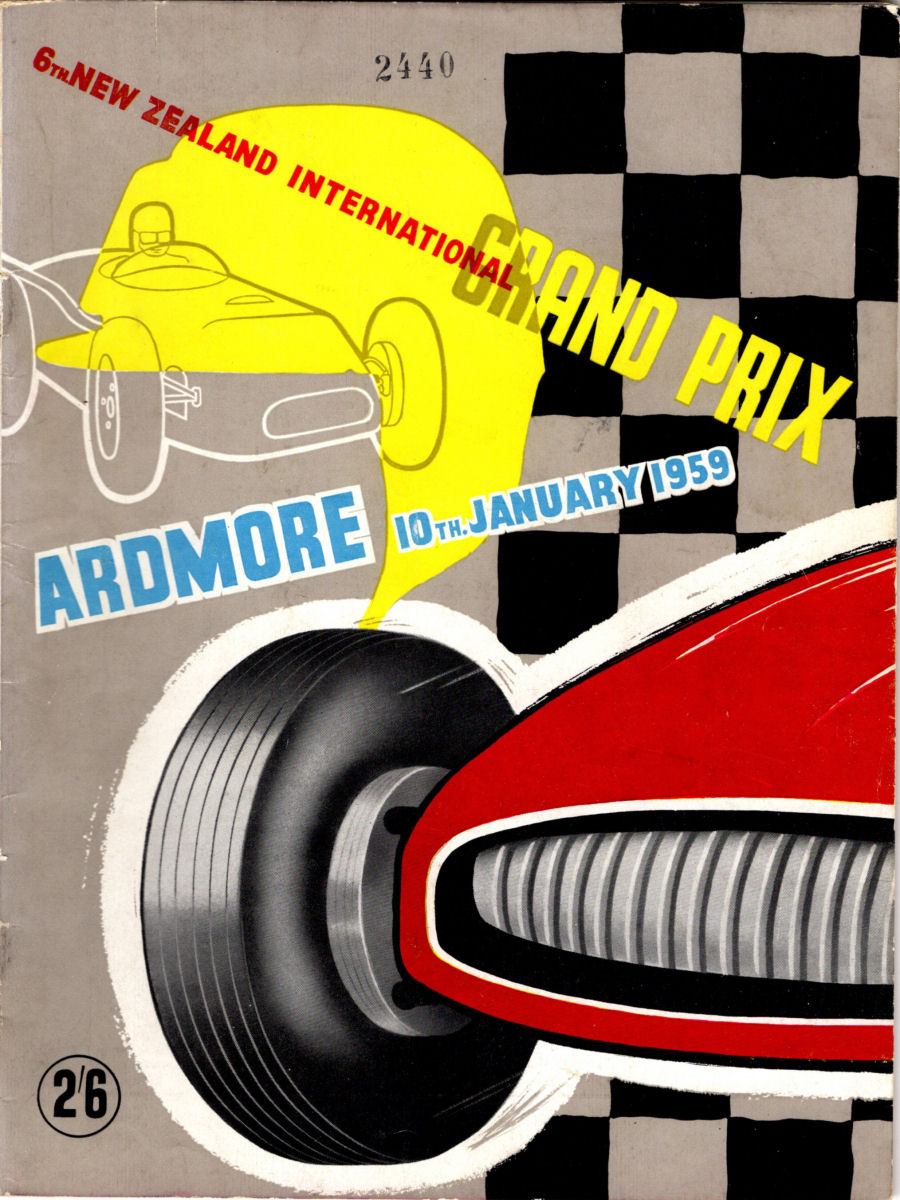

It included the best driver in the world by common consent, Stirling Moss, who shot through the 150 miles at fantastic speed, smashing every previous record in the very warm 2015cc Rob Walker Cooper-Climax, and several other ranking drivers, including Brabham, the winner of the year before, up-and-coming Bruce McLaren (they were to follow Moss home in a Cooper benefit), Ron Flockhart in the latest BRM, Harry Schell, Carroll Shelby, Joakim Bonnier - and New Zealand's Ross Jensen in yet another Maserati.
This astonishing field, which would have graced the front ranks of the grid in any major Grand Prix, had been assembled largely through the barnstorming tour by the NZIGP's livewire secretary Frank ("Buzz") Perkins, who had taken off the previous July, followed the circuits of Europe, and signed up everyone in sight, including the eventual world champion, Mike Hawthorn, whose grim tenacity won him the 1958 crown in the face of the greater brilliance of Moss.
However, after winning the Italian Grand Prix at Monza, Hawthorn, who had provisionally been signed up by Perkins to come to New Zealand, decided that if he won the championship at Casablanca, he would retire from grand prix racing.
The two men met in a hotel, discussed the position, and in view of Hawthorn's almost certain crown, agreed to tear the contract up. It dropped in fragments into the wastepaper basket.
Hawthorn won his championship and retired from racing. The New Zealand Grand Prix was run on January 10, and on January 19 Hawthorn met his death when his Jaguar, travelling at over 80 mph, skidded on a greasy main highway south of London. Had he come to New Zealand he might still have been alive.
Such are the fortunes of racing. Even without Hawthorn, the field was a brilliant one on paper, and the expected enormous crowd duly turned up. There were, however, some old faces missing from the 1959 entry. Stewart Lewis-Evans had been killed at Casablanca, Archie Scott-Brown died at Spa and Peter Whitehead had been fatally injured as a passenger in the Tour de France.
Brabham and McLaren were to drive the works Coopers, of 2200 cc and 1960 cc respectively, Flockhart the first works entry - the latest model BRM P25 - other than Cooper to come to the country.
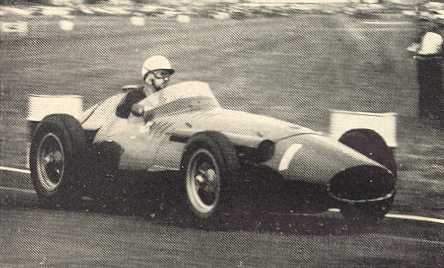
Jo Bonnier in his Maserati 250F.
All sorts of rumours were current beforehand as to the might of the Maserati entry. By this time, the Modena factory was kept going only with the support of American finance and oil millionaire Temple Buell, who had in effect taken over the racing management of the Maserati concern.
The cars, to be driven by Harry Schell and the colourful Texan Carroll Shelby, of later Shelby Cobra fame, were rumoured to be the latest "Piccolo" design - the ultra-lightweight model under development at the time Fangio left racing - and one of them was to have a motor with the new desmodromic valve gear, operated mechanically instead of by return springs.
Travelling in company with the Buell stable, but as an independent, was wealthy Swedish driver Joakim Bonnier, with the actual prototype lightweight which had been driven by Fangio, and finally, also under the Maserati banner, was Ross Jensen, in a car built round the frame of the Bira race-winner of 1955, but with the latest motor and transmission, giving the low, off-set driving position.
And finally the great Guerino Bertocchi, famous old-time racing driver and Maserati's chief tester, was to be on the spot to supervise preparation and running of the Buell cars.In addition to this impressive list, there was a strong entry from New Zealand, and a lesser one from Australia for this year.
Tom Clark, by now recovered from his serious smash of 15 months before, was on deck again with the Super-Squalo Ferrari, and Arnold Glass came over from Sydney with the sister-car, right up to scratch after a refit at Maranello, getting a new 625/555 motor in the process. Pat Hoare brought the 625 Ferrari from Christchurch again, Syd Jensen had returned from his successful British and Continental tour with his Cooper T45 fitted out with a F2 1500cc FPF, (he had hoped to get a 1960 cc motor, but was disappointed).
Johnny Mansel was to drive his own ex-Quirk car, but at the last moment he was able to buy Ross Jensen's ex-Moss 250F Maserati and the Cooper-Bristol went driverless, eventually ending up in the hands of Brian Prescott. Mansel thereby jumped several steps up the ladder. Bib Stillwell had a similar ex-Hunt Maserati 250F, with disc brakes, with which he had run here before, and Gavin Quirk entered his Maserati 250F. Ron Roycroft entered his Ferrari 375 as before.
Merv Neil, who had also performed well overseas returned home, via Australia for a couple of races, with a brand new 2-litre FPF for his Cooper T45. Ray Thackwell returned with a T43 with 1500cc motor and Tony Shelly the single-cam T41 model. There were no Formula III Coopers for the first time since the inception of the race.
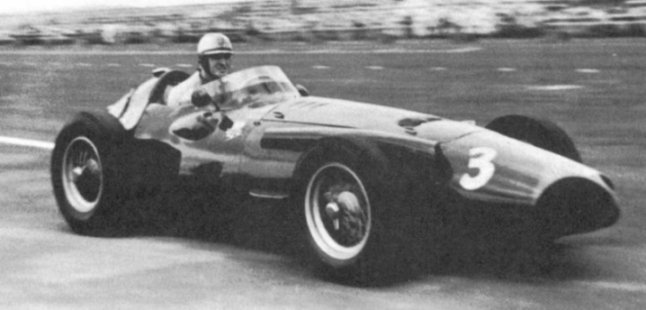
Allan Freeman returned with his Lago-Talbot, Ron Duncan brought the Connaught out for another attempt, and Brian Tracey displayed the ex-Moore/Roycroft/Mansel Alfa Romeo for another year.
The 'specials' were once again led by Watson's Lycoming, now having an even better chance with Bob Gibbons at the wheel. The Normac Special, driven by Reg McCutcheon failed to qualify.
Frank Cantwell (Tojeiro-Jaguar 3442cc) was again leading sports-car driver, backed up by a much improved Ken Harris (Monza Ferrari) and the Austin-Healey's of Graham Pierce and South Island driver Max Richards.
When the cars arrived, there were none of the usual troubles over unloading which had beset the organisation in earlier years, but there were troubles with several of the cars, beginning with the Moss Cooper.
The car driven by Moss was fitted with an Alf Francis built 2-litre Climax FPF. It was not the normal engine which rated at 19644cc, but a special cam variety with Francis specification crank which increased the stroke to give 2015cc. The car had won the Australian Grand Prix at the beginning of December finishing very hot and short of water, but spares had been flown out and the damage was made good before practice-day.
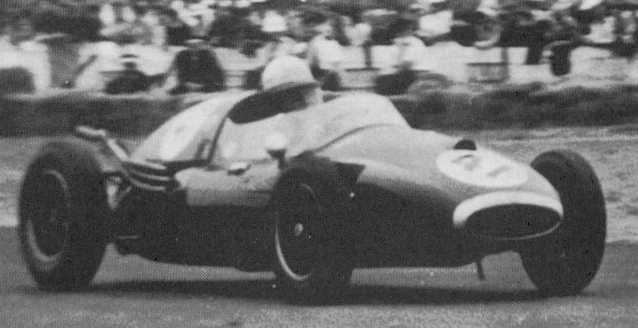
Bruce McLaren (Cooper-Climax).
On arrival, the bunch of Maseratis had proved slightly disappointing. The Bonnier car had raced in the first United States Grand Prix at Watkins Glen and was not in the happiest condition, and neither of the Buell cars had the expected desmodromic valve system. They were, however, right up to the mark in other respects, the one to be driven by Shelby having a very high tail, similar to the Vanwall and quite unlike the traditional Maserati line.
Ross Jensen's car was the prettiest of them all, the offset transmission giving it a very low silhouette. And quietly and cunningly, working on bitter experience, Jensen swapped the brake linings for some more suited to the adversities of the Ardmore circuit for the anchor department. This was to have quite an effect on the day of the race.
It was in the braking department that the Coopers were expected, despite the formidable opposition, to have a sufficient advantage to take the trophy. All three of the principal cars and Syd Jensen's were fitted with disc brakes. So was the heavier, longer BRM, but all the Maseratis still had drum brakes, albeit wider and heavily-finned, with the sole exception of Stillwell's.The results of this differential in braking were still in the future at this stage, however, and while the rumours flew thick and fast, the cars were tuned in secret ready for practice.
First out to practice - his car was ready a week before the event - was Ron Flockhart, test driver for the Owen Organisation, which races BRM, and a winner of the Le Mans 24-hour and many other races.
From this first trot round, it was clear that every record would go by the board, either on the day or in practice, for Flockhart rattled up a time of 1m 23.6s, or 86.7 mph, over two seconds faster than the 1m 26s put up by Ross Jensen in the ex-Moss Maserati during the "Little Ardmore" meeting after the previous year's grand prix.
More was to come, for on the official day, Moss made his first appearance - and shot round the course in the dark blue, almost black, Cooper at 86.7 mph, lapping in 1m 23s. He was followed by Brabham a second slower, Flockhart put in a lap at 1.24.5, Bruce McLaren 1.26.2, Ross Jensen 1.26.3 and Harry Schell 1.26.4. Five thousand unexpected visitors turned up to see the practice, despite official warnings to keep away from the course.
And the seal was set on the afternoon by a tremendous lap by Moss in 1.21.5, a time which caught organisers napping by being right off the official time-to-speed conversion chart. This was 5 seconds better than Jensen's record.
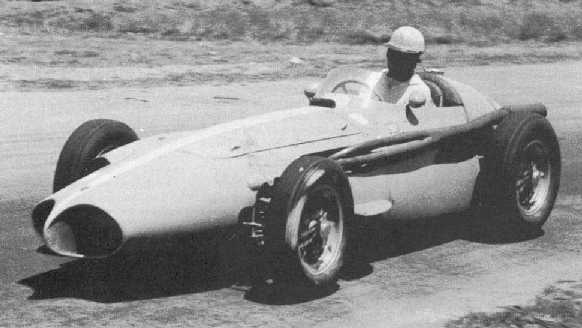
Ross Jensen (Maserati 250F).
Moss' driving in practice could only be described as fantastic, and no-one who was there will ever forget the sight of the Cooper coming out of the left-hander into Pit Straight, travelling at well over 100 mph and literally bucking with the acceleration, while Moss coolly kept the car in line.
By the time all the cars had qualified for the two heats, half the starters had got down to less than the 1m 30s which had been considered mighty fast motoring in the previous years.
In the Cooper and Rob Walker pits, everything was calm and confident. Walker, incidentally, is a wealthy Britisher, one of the whisky clan, a former racing driver who maintains a stable of Formula I and II cars, usually driven by Moss or Trintignant. He was, by a coincidence, driving close behind Hawthorn when the latter met his death, and had not been at the Ardmore race to see Moss' win.But in those of the Maserati establishment, things were not so happy. The ebullient Schell and the equally ebullient Bertocchi were not in agreement over tactics, though all the drivers and Bertocchi were unhappy over the braking situation.
Even in practice, Shelby's car was suffering from grabbing brakes, though both machines were going well otherwise. It was eventually decided to run the cars without a full complement of fuel, risking a pit stop in an effort to lighten the load on the braking systems.
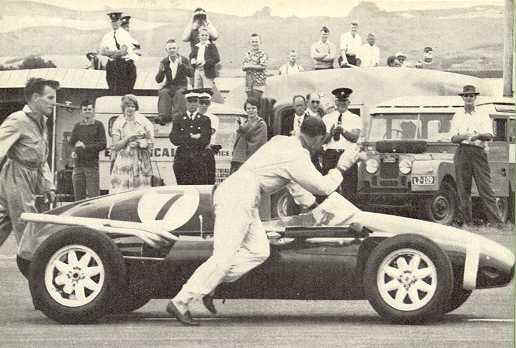
Moss waving to the crowd as he pushes
the Cooper over the line in the second heat.
Sensation of race day, ranking with McLaren's mishap of the year before, came when the crowd groaned to see Moss, away ahead of the field, coast to a halt after the Cloverleaf on the last lap of his heat, looking anxiously down at the rear transmission.
Throwing off his helmet and leaping out, Moss pushed the car home the 400 yards to the finishing-line, and in the pits it was found that the universal yoke to the offside half-shaft had sheared. Although he was not among the twenty-four fastest to finish the heats, Moss, being an overseas entry, had his start guaranteed. All he needed was a replacement for his broken half-shaft.Then came one of the most sporting gestures in the history of racing - though perhaps in the circumstances inevitable. Moss had no half-shaft among his spares, but Brabham had a complete spare Cooper standing in the pits. Without hesitation, Brabham offered the shaft and the Moss pit crew set to work desperately to make good the damage.
They succeeded, but barely in time for the sweating Moss (once again it was a superb summer's day) to ease himself into the cockpit for the main event and take his place, at the back of the grid.
The heats themselves, each of 30 miles, otherwise brought few surprises. Brabham won the first in 21m 48s, with a fastest lap of 1.25.8 (84 mph), ahead of McLaren, Bonnier, Schell and Stillwell, indicating that the Maseratis were going to be outclassed by the Coopers from the outset. Bob Gibbons, who actually led for some time, was sixth in the Lycoming.
After having to concede the lead to Moss in the early stages of the second heat, Flockhart came up to first place with the BRM on Moss' retirement, followed by Shelby, Ross Jensen, Syd Jensen and Mansel. Race time was 21m 40s, and the fastest lap 1.24.2 (85.2 mph) was shared by Moss and Flockhart.
Pole position on the grid was naturally taken by Flockhart, followed by Brabham, McLaren, Bonnier, Schell, Shelby, Ross Jensen, Stillwell, Gibbons, Syd Jensen, Mansel, Clark, Hoare, Neil, Thackwell, Glass, Quirk, Harris, Gilbert, Freeman, Moss and Shelly. Although Tracey, Pierce and Duncan qualified, they thought it futile to risk their cars in an effort to gain a place.
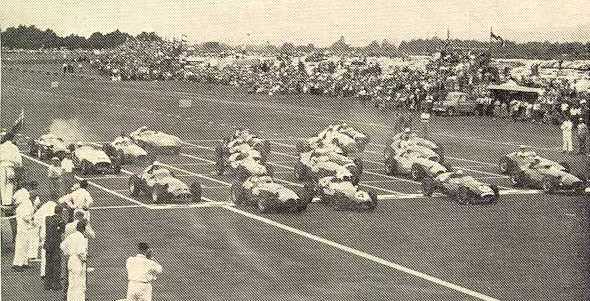
Once again Moss' driving at the start of that race deserved the epithet "fantastic." From the back of the grid he cut through every available gap, and some that did not seem to be available, to be lying sixth in the field of 21 by the time the cars reached the end of the straight and turned into College Corner, 600 yards away.
The three stable Maseratis were in the lead from the start, Harry Schell making one of his famous (or notorious) fast starts from the second row, to tail Bonnier with Shelby lying third. In fourth place was Brabham, followed by McLaren, Moss, Neil and Stillwell.
Along the back straight, having by then overtaken all but Schell, Bonnier and Brabham, Moss jumped Brabham, but was in turn overtaken by Brabham going into the Cloverleaf.
By a display of his driving at its most superb, Moss cut out three of the world's best drivers in a matter of half a mile, roaring into Pit Straight in the lead at the end of the first lap, an astounding piece of driving.
He was followed by Bonnier, Schell and Brabham, with Shelby a wheel's distance ahead of McLaren and Stillwell. By the fourth lap, Moss had surged away to a 60-yard lead ahead of Brabham, with Schell, Bonnier, Shelby and McLaren on his tail. The rest were Ross Jensen, Stillwell, Clark, Neil, Mansel and Syd Jensen.
The BRM had meanwhile been making up lost ground spectacularly, but by the sixth lap, Flockhart had come up to fourth place, following a spin by McLaren, which had dropped him back to eighth. There ensued a battle royal between Jensen, who challenged Flockhart for the position, and the BRM which lasted until the 14th lap.
Bearded Bonnier had departed from the scene on the fifth lap, a fuel leak forcing a visit to the pits; after losing two laps he was in the fray again, worked up to 10th position, and finally left the scene on the 41st lap with a steering defect.
At the end of 19 laps, Moss had lapped all but six of the field, was 35 seconds ahead of Brabham and on the way to lapping Schell. Flockhart had moved up to third place, Jensen was lying fourth, and Shelby and McLaren were disputing the fifth position, a duel which ended on the 20th lap when McLaren pipped the high-tailed Maserati on the Cloverleaf.
Two consistent drivers were Stillwell and Syd Jensen, who retained their places next over the first 20 laps as the leaders fought it out, and behind them came the bright red Super Squalo driven by Clark.
Moss was a good half-lap ahead of Brabham on the 22nd lap, while Flockhart, who had clocked 144 mph along the back straight, was making ground on Brabham's Cooper.
Hard on Jensen's heels (he was lying third) came McLaren and Shelby, the trio holding station together for a number of laps. Next came Schell in the other and faster Buell Maserati, but oil fumes were rising from it and the motor was missing.
On the next lap round, Jensen was in third place and Flockhart absent. A minute or two later, he coasted into the pits. The bonnet was lifted, and a mechanic threw a pipe into the pits in disgust; it was the oil breather, which had come adrift and allowed oil to spurt out on to the rear tyres. So ended yet another BRM bid for the New Zealand Grand Prix.
After two more laps, during which Moss put in his fastest lap, one of 1m 24.8s (85 mph), and reached 152 mph on the back straight, Moss had lengthened his lead to a lap. He and Brabham both lapped a very groggy Schell, who came into the pits, overcome by fumes from oil leaking through a loosened cylinder head stud on to the red-hot exhaust manifold.
This left the two Coopers roaring away out in front, Jensen and McLaren having a private dogfight with Shelby over the next three positions. At half-way, the position was the same, with the rest of the positions filled by Stillwell, Syd Jensen, Gibbons, Neil, Clark and Mansel.
At this stage, it looked as though McLaren was going smoothly and happily, with Jensen in much the same vein, both having a slight edge on Shelby.
But the spectators were not to know that McLaren was changing gears with his glove torn to tatters and the skin already working off the palm of his hand, after losing the knob of the gear-lever on his early spin out.
And Jensen's car was beginning to show signs of clutch trouble which was to dog him for the rest of the race; towards the finish the car was completely clutchless, and Jensen was making his changes on engine note alone.
Shelby was not without his trouble, for although he took Jensen and McLaren to sit in third position, with the white-streaked, high-tailed Maserati sounding healthy, he was, suffering from agonising cramp in one leg – and his brakes were beginning to fade.
Finally he stopped at the pits on lap 41, hopping around on one leg while Harry Schell leapt into the car and set off after the leaders. Driving furiously, he had pulled himself up into fifth place behind Jensen by the 51st lap, and in the meantime McLaren had finally established a lead over the low, light-blue Jensen Maserati, to be now lying in third position.
Moss was going great guns, and Brabham's only hope, as he sat quietly the best part of a lap behind, was that the other half- shaft would break, or some other disaster overcome Moss.
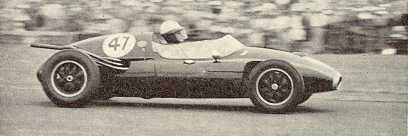
Bruce McLaren in the Cooper on his way
to third place.
As Jensen's clutch deteriorated and his motor sickened, Schell overhauled him rapidly, shooting past on the back straight on lap 63. The leading group was so far ahead of the rest of the field, headed by Bib Stillwell and Syd Jensen in the little Formula II Cooper, that Jensen was still able to run on into fifth position, despite a spin on the second-to-last lap.
Meanwhile Schell's desperate bid to put the Maserati further up the scale had failed, not only because of the superlative driving of Moss, but also through the complete failure of the drum brakes before the end of the race.
A challenge to McLaren failed completely, for by this time the linings of the rear brakes had been welded to the drum castings by heat, torn clean off the shoes, and only Schell's experience carried him through.
Moss never did lap Brabham during the 75 lap duration, but he did lap McLaren in the closing stages, when the young New Zealander, his hand torn and bleeding from the threads on the gear-lever and his motor not the happiest after over-revving earlier in the race, had also cut back his speed.
Once again the redoubtable Lycoming Special, this time in the hands of Bob Gibbons, had proved that it could outlast and outpace many a regular grand prix car to finish eighth, ahead of Merv Neil. Tom Clark had driven his last race in the big red Ferrari, coming in 10th despite a spin late in the race.
Probably 80,000 people saw the race, a record for any type of sporting event in New Zealand.
Moss' time, 1h 48m 24.4s, an average of 82.8 mph., was over three miles faster than Brabham's winning drive over exactly the same course the year before, and he put in a lap of 1m 24.8s (85 mph), also a race record, though well outside his remarkable 1.21.5 in practice.
| Result | Driver | Nat | Car | Laps | Time |
| 1 | Stirling Moss | UK | Cooper T45 / Climax 2015cc 4cyl | 75 | 108m 24.4s |
| 2 | Jack Brabham | Aust | Cooper T45 / Climax 2202cc 4cyl | 75 | 109m 53.4s |
| 3 | Bruce McLaren | NZ | Cooper T45 / Climax 1964cc 4cyl | 74 | |
| 4 | Carroll Shelby / Harry Schell | USA / France | Maserati 250F / Maserati 2493cc 6cyl | 73 | |
| 5 | Ross Jensen | NZ | Maserati 250F / Maserati 2493cc 6cyl | 72 | |
| 6 | Bib Stillwell | Aust | Maserati 250F / Maserati 2497cc 6cyl | 72 | |
| 7 | Syd Jensen | NZ | Cooper T45 / Climax 1460cc 4cyl | 72 | |
| 8 | Bob Gibbons | NZ | Lycoming Special / Lycoming 4733cc 4cyl | 72 | |
| 9 | Merv Neil | NZ | Cooper T45 / Climax 1960cc 4cyl | 71 | |
| 10 | Tom Clark | NZ | Ferrari Super Squalo 555 / Ferrari 3431cc 4cyl | 70 | |
| 11 | Pat Hoare | NZ | Ferrari 625 / Ferrari 2996cc 4cyl | 70 | |
| 12 | Arnold Glass | Aust | Ferrari Super Squalo 555 / Ferrari 2497cc 4cyl | 68 | |
| 13 | Len Gilbert | NZ | Cooper-Bristol Mk II / Bristol 1971cc 6cyl | 66 | |
| 14 | Ken Harris | NZ | Ferrari 750 Monza / Ferrari 2999cc 4cyl | 65 | |
| 15 | Gavin Quirk | NZ | Maserati 250F / Maserati 2497cc 6cyl | 63 | |
| Ret | Johnny Mansel | NZ | Maserati 250F / Maserati 2497cc 6cyl | 59 | Engine |
| 16. | Allan Freeman | NZ | Lago-Talbot 26C / Talbot 4485cc 6cyl | 58 | |
| Ret | Ray Thackwell | NZ | Cooper T43 / Climax 1460cc 4cyl | 47 | Engine |
| Ret | Joakim Bonnier | Sweden | Maserati 250F / Maserati 2493cc 6cyl | 41 | Steering |
| Ret | Harry Schell | France | Maserati 250F / Maserati 2493cc 6cyl | 24 | Oil Leak |
| Ret | Ron Flockhart | Scot | BRM P25 / BRM 2497cc 4cyl | 24 | Oil Leak |
| Ret | Tony Shelly | NZ | Cooper T41 / Climax 1496cc 4cyl |
0 |
|
| DNS | Ron Duncan | NZ | Connaught A / Lea Francis 1964cc 4cyl s/c | ||
| DNQ | Frank Cantwell |
NZ | Tojeiro 3/56 / Jaguar 3442cc 6cyl | ||
| DNQ | Ron Roycroft | NZ | Ferrari 375 / Ferrari 4493cc V12 | ||
| DNQ | Brian Tracey | NZ | Alfa Romeo Tipo B / Alfa 2905cc 8cyl s/c | ||
| DNQ | Graham Pierce | NZ | Austin-Healey 100S / Austin 2660cc 4cyl | ||
| DNQ | Reg McCutcheon | NZ | Normac Special III / Chevrolet 3930cc 6cyl | ||
| DNQ | Max Richards | NZ | Austin-Healey 100S / Austin 2660cc 4cyl | ||
| DNA | Jack Malcolm | NZ | Cooper-Bristol Mk II / Holden 2258cc 6cyl | ||
| DNA | Giorgio Scarlatti | Italy | Maserati 250F / Maserati 4477cc V8 | ||
| DNA | Chan Lye Choon | Singapore | Aston-Martin DB3S / Aston 2996cc 6cyl | ||
| DNA | John Cullen | NZ | Cullen 500 / Norton 498cc 1cyl |